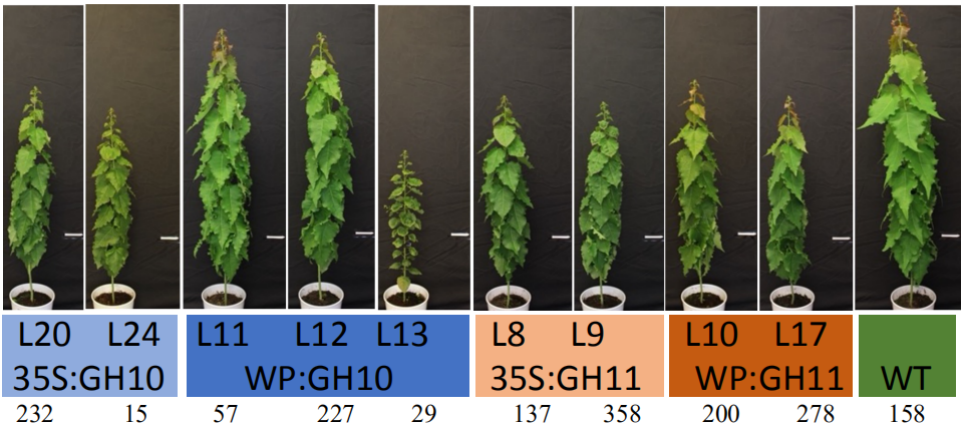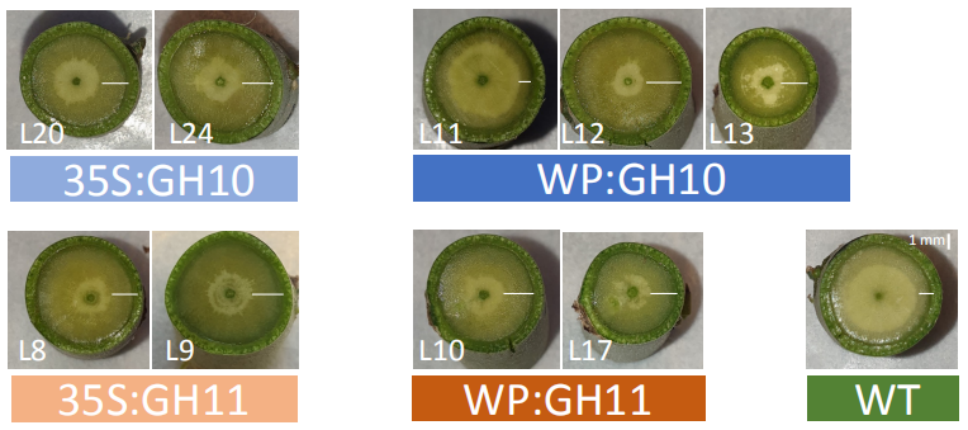品质至上,客户至上,您的满意就是我们的目标
技术文章
当前位置: 首页 > 技术文章
WIWAM植物表型成像系统:次生壁中木聚糖的修饰改变了细胞壁的生物合成和木材形成程序
发表时间:2024-05-09 14:03:55点击:474
来源:北京博普特科技有限公司
分享:
WIWAM植物表型成像系统由比利时SMO公司与Ghent大学VIB研究所研制生产,整合了LED植物智能培养、自动 化控制系统、叶绿素荧光成像测量分析、植物热成像分析、植物近红外成像分析、植物高光谱分析、植物多光谱分 析、植物CT断层扫描分析、自动条码识别管理、RGB真彩3D成像等多项先进技术,以较优化的方式实现大量植物样 品——从拟南芥、玉米到各种其它植物的生理生态与形态结构成像分析,用于高通量植物表型成像分析测量、植 物胁迫响应成像分析测量、植物生长分析测量、生态毒理学研究、性状识别及植物生理生态分析研究等。

摘要
阔叶树种的木材是生物精炼厂可再生生物质的重要来源,也是遗传改良工作的目标是降低其抗降解屏障。葡萄糖醛酸氧聚糖 (GX) 通过与纤维素和木质素的相互作用在抗降解屏障中起关键作用。为了降低顽固性,我们通过在杂交白杨(Populus tremula L. x tremuloides Michx.)中表达来自芝麻曲霉的GH10和GH11内氧烷酶并将酶靶向细胞壁来修饰木材GX。木聚糖酶降低了树高,通过增加韧皮部和减少木质部改变了形成层活性,并减少了次生壁沉积。在转基因系中,木聚糖分子量降低,乙酰基和MeGlcA侧链间距减小。转基因树产生的木质部具有薄的次生壁和变形的维管。未经预处理的酶促糖化的葡萄糖产量几乎翻了一番,表明耐药性降低。转录组学、激素组学和代谢组学数据为细胞分裂素和乙烯信号通路的激活、ABA水平的降低、木质化的抑制和次级壁生物合成程序的一个子集提供了证据,包括木聚糖葡萄糖醛酸化和乙酰化机制。检测到几个木聚糖完整性受损的候选基因。这些候选基因可以提供一个新的目标,将负面增长效应与减少的顽固性脱钩。总之,我们的研究支持了木聚糖修饰产生内在信号并唤起调节树木生长和次生壁生物合成的新途径的假设。


Modification of xylan in secondary walls alters cell wall biosynthesis and wood formation programs
Abstract
Wood of broad-leaf tree species is a valued source of renewable biomass for biorefinery and a target for genetic improvement efforts to reduce its recalcitrance. Glucuronoxylan (GX) plays a key role in recalcitrance through its interactions with cellulose and lignin. To reduce recalcitrance, we modified wood GX by expressing GH10 and GH11 endoxylanases from Aspergillus nidulans in hybrid aspen (Populus tremula L. x tremuloides Michx.) and targeting the enzymes to cell wall. The xylanases reduced tree height, modified cambial activity by increasing phloem and reducing xylem production, and reduced secondary wall deposition. Xylan molecular weight was decreased, and the spacing between acetyl and MeGlcA side chains was reduced in transgenic lines. The transgenic trees produced hypolignified xylem having thin secondary walls and deformed vessels. Glucose yields of enzymatic saccharification without pretreatment almost doubled indicating decreased recalcitrance. The transcriptomics, hormonomics and metabolomics data provided evidence for activation of cytokinin and ethylene signaling pathways, decrease in ABA levels,ranscriptional suppression of lignification and a subset of secondary wall biosynthetic program, including xylan glucuronidation and acetylation machinery . Several candidate genes for perception of impairment in xylan integrity were detected. These candidates could provide a new target for uncoupling negative growth effects from reduced recalcitrance. In conclusion, our study supports the hypothesis that xylan modification generates intrinsic signals and evokes novel pathways regulating tree growth and secondary wall biosynthesis.
Plant growth in the greenhouse
In vitro propagated saplings were planted in soil (K-jord, Hasselfors Garden AB, Örebro, Sweden) in 7 L plastic pots, watered to 25% -30% (v:v) soil moisture content, covered with transparent 8 L plastic bags, and grown for nine weeks in the phenotyping platform (WIWAM Conveyor, custom designed by SMO, Eeklo, Belgium) as described by Wang et al. (2022) under 18 h /6 h (day/night) light regime with 160-230 µmol m-2s -1light intensity during the day, 22 °C /18 °C temperature,
and the average air relative humidity of 60%. White light (FL300 LED Sunlight v1.1) and far-red light (FL100 LED custom-made, 725-735 nm) lamps from Senmatic A/S (Søndersø, Denmark) were used for illumination. After two weeks the bags were removed, and plants were watered automatically based on weight, their height was automatically measured. At the end of experiment, trees were photographed, and stems diameters at base and aboveground fresh weights were recorded. A 30 cm-long stem segment above internode 37 was debarked, frozen in liquid nitrogen and stored at -70 °C for RNA, metabolomics and hormonomics analyses. The stem below was used for determining internode length. The 38th and 39th internodes were used for microscopy analyses. The four-cm long bottom segment was used for SilviScan analysis, and the remaining stem was debarked and freeze-dried for 48 h for wood chemistry analyses. Belowground biomass was determined by weighing cleaned and air-dried roots.